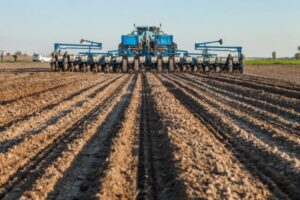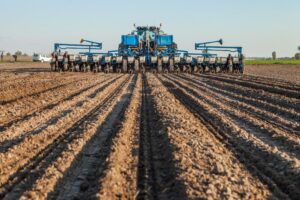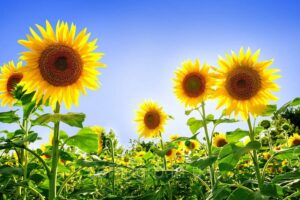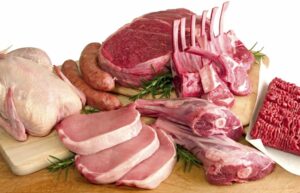
Prime Minister Denys Shmygal asks Denmark to consider the possibility of supplying Ukraine with raw materials needed for farmers and oil products.
“I thanked for the decision to take part in the restoration of the city of Nikolaev together with other international partners. Also, in the coming days, as Prime Minister Matte Frederiksen promised, Ukraine will receive equipment and machinery that will help in the restoration of the liberated cities,” Shmyhal wrote on the Telegram channel following a meeting with Danish Foreign Minister Jeppe Kofodom.
According to him, the parties discussed the supply of military equipment, the tightening of sanctions against Russia and the rejection of Russian energy resources.
“I touched upon the issue of diversifying gas supply sources. I made a proposal to consider the possibility of supplying Ukraine with raw materials needed for farmers and oil products, since the enemy is purposefully trying to disrupt the sowing season and cause a shortage of fuel,” the prime minister wrote.
Among other things, Shmygal thanked Denmark for its strong political and financial support.
“We also count on Ukraine’s support in acquiring the status of a candidate for EU membership and on the approval decision of the European Commission to suspend import duties on all Ukrainian exports for a year,” he added.

For the period from mid-March to April 13, Ukrainian banking institutions provided loans to farmers under the state program to support the sowing campaign-2022 for a total of UAH 5.43 billion, including loans and portfolio guarantees for the week of March 6-13. UAH 3.64 billion
The relevant data on the financing of the sowing campaign in the context of the Russian military invasion of Ukraine was published on the website of the Ministry of Agrarian Policy and Food of Ukraine on Thursday.
“In fact, over a week, loans were issued for more than UAH 3.6 billion for more than a thousand farmers. Banks took a rather fast pace to cover the needs of our agricultural producers, who are now undergoing a sowing campaign. Today, agricultural loans can be issued by 22 Bank, and the goal of the state is to increase lending to the agricultural sector up to UAH 40 billion, that is, almost eight times more,” the department quotes its head, Mykola Solsky.
It is specified that 80% (UAH 4.41 billion) of the provided borrowed funds were portfolio guarantees, while 2.08 thousand agricultural producers received access to financing in total (1.18 thousand in the last week).
Most of the loans for the sowing campaign were attracted by the agrarians of Kirovohrad region – UAH 1.81 billion (+UAH 1.4 billion for the week), Vinnitsa region – UAH 944 million (+UAH 579 million), Dnepropetrovsk region – UAH 738 million (+UAH 471 million), Odesa – UAH 549 million (+UAH 388 million) and Lviv – UAH 348 million (+UAH 189 million) regions.
According to the Ministry of Agrarian Policy, loans up to UAH 60 million under this program are issued at 0% per annum (under the state financial support program “Affordable loans 5-7-9%”). The term of such lending is up to six months, and after its completion, the interest rate for borrowers will be 5% per annum. Agrarians falling under the definition of an agricultural producer can use the loan.
“Ukraine understands its defining role as a guarantor of the food security of the world, so we must harvest to feed ourselves, and also prevent food shortages and hunger in the world,” Solsky summed up in the message of the Ministry of Agrarian Policy.
The agency recalled that the government program to support the sowing campaign is being implemented by the Cabinet of Ministers, the Ministry of Agrarian Policy, the Ministry of Finance, the Ministry of Economy, the National Bank and the banking sector.
As reported, at the end of March, the Cabinet of Ministers of Ukraine expanded the procedure for issuing guarantees for agricultural producers on loans on a portfolio basis for the purchase of the resources they need for the sowing campaign in 2022, since due to the Russian military invasion of Ukraine, part of the farmers lost working capital for carrying out spring work.
Thus, within the framework of portfolio lending to agricultural producers, they will be able to obtain loans for the purchase of fertilizers, plant protection products, pesticides and agrochemicals, fuel, spare parts for agricultural equipment, as well as for replenishment of fixed assets and intangible assets, wages, rent of real estate and movable property, works and services for its operations.
The total budget of this program to support the 2022 sowing season is UAH 50 billion.

Ukrainian banking institutions for the period from mid-March to April 5 issued loans to farmers as part of the state program to support the sowing campaign in the context of the Russian military invasion of Ukraine for a total of UAH 1.79 billion, according to the website of the Ministry of Agrarian Policy and Food of Ukraine on Wednesday.
At the same time, it is specified that currently 80% (UAH 1.5 billion) of the provided borrowed funds were portfolio guarantees, and 900 agricultural producers from different regions of the country received access to financing.
Most of all loans for the specified period were attracted by farmers of Kirovohrad region – UAH 405 million (22% of the total), Vinnitsa region – UAH 365 million (20.4%), Dnepropetrovsk region – UAH 267 million (14.9%), Odessa region – UAH 161 million (9%) and Lviv – UAH 159 million (8%) regions.
According to the Ministry of Agrarian Policy, loans up to UAH 60 million under this program are issued at 0% per annum (under the state financial support program “Affordable loans 5-7-9%”). The term of such lending is up to 6 months, and after its completion, the interest rate for borrowers will be 5% per annum. Agrarians falling under the definition of an agricultural producer can use the loan.
“Lending to farmers is one of the main priorities of banks. The conditions for granting loans are simplified as much as possible. Moreover, banks lend to our farmers even in those regions where there are battles, because they need to sow, and (…) people go out to their fields,” the ministry quotes its head of Nikolai Solsky.
The agency clarified that the government program to support the sowing campaign is being implemented by the Cabinet of Ministers, the Ministry of Agrarian Policy, the Ministry of Finance, the Ministry of Economy, the National Bank and the banking sector.
As reported, at the end of March, the Cabinet of Ministers of Ukraine expanded the procedure for issuing guarantees for agricultural producers on loans on a portfolio basis for the purchase of the resources they need for the sowing campaign in 2022, since due to the Russian military invasion of Ukraine, part of the farmers lost working capital for carrying out spring work.
Thus, within the framework of portfolio lending to agricultural producers, they will be able to obtain loans for the purchase of fertilizers, plant protection products, pesticides and agrochemicals, fuel, spare parts for agricultural equipment, as well as for replenishment of fixed assets and intangible assets, wages, rent of real estate and movable property, works and services for its operations.
The total budget of this program to support the 2022 sowing season is UAH 50 billion.

American farmers plan to significantly increase sunflower crops this year due to supply disruptions amid Russia’s military invasion of Ukraine, Bloomberg writes.
At the same time, a jump in agricultural prices to record levels for many years could increase motivation among farmers to plant more, said John Sandbakken, executive director of the National Sunflower Association. The USDA tentatively forecasts a 10% increase in sunflower acreage this year.
“I’m sure the increase will be more, almost 20%,” Sandbakken said in a telephone interview with Bloomberg.
Sunflower is used in a very wide range of products, from potato chips and sunflower oil for frying to bird food and shampoos. However, this year this commodity may be in short supply, as Ukrainian farmers are forced to reduce acreage and exports due to hostilities in the country. Ukraine is considered one of the world’s largest sunflower exporters.
Meanwhile, last year’s devastating drought in the northern Great Plains of the United States plays into the hands of American farmers this year, as it left excess nitrogen in the ground, which reduces fertilizer costs, Bloomberg notes.
The price of new crop sunflower in the US is about $34 per 100 pounds (about 45 kg), higher than the previous record price of $30.5 reached in 2008. Old crop sunflower prices are also nearing their highest since 2011, Sandbakken notes.

The Ministry of Agrarian Policy and Food of Ukraine has launched a questionnaire website for farmers to find out their readiness and needs before spring field work and sowing, as well as to clarify how the agency can effectively help them at the expense of state funds and international support.
The department wrote about the launch of the corresponding website on its Facebook page on Monday.
“Now millions of Ukrainians rely on us, because you, farmers, are the basis of the economic development of the state. Therefore, the Ministry of Agrarian Policy has taken on additional functions to coordinate the distribution of everything that is necessary to ensure the sowing campaign-2022 (diesel fuel, seed material, fertilizers, protective equipment). A special platform agrostatus.org has been created for this,” the ministry said in a statement.
According to it, the online survey will make it possible to find out the needs of farmers for a successful start of the sowing campaign, to help cover these needs at the expense of the state and international support.
The Ministry of Agrarian Policy specified that agrarians using the service should fill out a special application on the website https://agrostatus.org/ according to their needs, after which the ministry will contact them and coordinate all further actions.

Sales of meat for slaughter in Ukraine (in live weight) in January of this year decreased by 1.5% compared to January 2021, to 307,300 tonnes, milk production – by 1.5%, to 522,100 tonnes, and eggs – by 8.1%, to 934.6 million pieces.
According to the website of the State Statistics Service, as of February 1, 2022, the total number of poultry in Ukraine increased by 0.7% compared to the same date last year, to 193.9 million birds. The number of pigs decreased by 3.4%, to 5.56 million animals, cattle – by 6.5%, to 2.7 million animals (including the number of cows – by 6.6%, to 1 .55 million animals), and sheep and goats – by 3.3%, to 1.09 million animals.
As of the indicated date, the number of cattle and pigs in the households of the population decreased the most – to 1.7 million animals of cattle (9.7% less versus February 1, 2021) and 1.92 million pigs (7.5% less). At the same time, by February 1, 2022, the country recorded an increase in the number of poultry at agricultural enterprises by 2.9%, to 110.9 million birds, and sheep and goats – by 8%, to 165,000 animals.
The population of cows at agricultural enterprises also increased by 0.2%, to 423,700 animals, while the total number of cattle decreased by 0.5%, to 1 million animals.
Sales of poultry for slaughter by agricultural enterprises in January 2022 increased by 3.8% compared to January a year earlier, to 56.96 million birds, sheep and goats – by 60.2%, to 3,700 animals, while sales of pigs decreased by 10.5%, to 0.35 million animals, and cattle – by 0.4%, to 23,100 animals.
Sales of eggs by agricultural enterprises for the specified period decreased by 12.3%, to 570,000 pieces, while the households reduced their sales by 1.4%, to 360,900 pieces.
The State Statistics Service specified that in January of this year, Kyiv region became the leader in production of eggs – 241.1 million eggs (9.3% less compared to January 2021), Khmelnytsky region – 68.6 million pieces (5.2% more), Dnipropetrovsk region – 56.1 million pieces (9.7% less) and Cherkasy region – 52.1 million pieces (13.7% less).
According to the statistics service, in January of this year, Ukrainian agricultural enterprises increased milk production by 6.9% compared to January last year, to 243,300 tonnes, while its production by households decreased by 7.8%, to 278,800 tonnes.
Most milk was produced in Poltava region – 50,900 tonnes (0.2% less), Vinnytsia region – 45,100 tonnes (7.8% less), Khmelnytsky – 40,000 tonnes (2.8% more), as well as Kharkiv and Cherkasy regions – by 34,000 tonnes (more by 2.1% and 2.7% respectively).